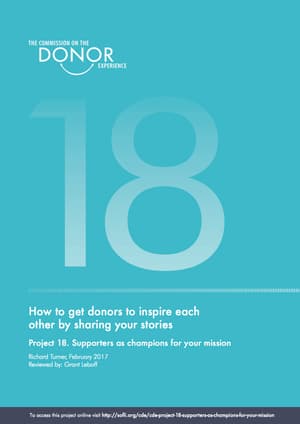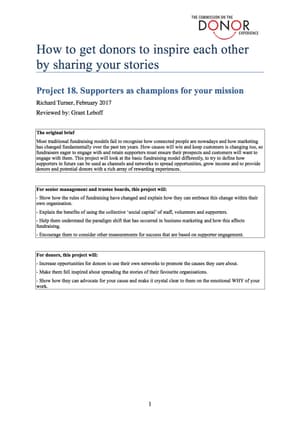CDE project 18 summary: supporters as champions for your mission
- Written by
- The Commission on the Donor Experience
- Added
- May 01, 2017
How to get donors to inspire each other by sharing your stories
Richard Turner, February 2017
Reviewed by: Grant Leboff
1. Summary
How did a small charity grow its annual unrestricted income fivefold in five years without significant investment in fundraising? How did a start-up charity in the US become a household name throughout fundraising and grow its income without any advertising spend? What is the mindset of the charity that results in community fundraising three times the national average and a fourfold net increase in income raised over four years? What is a key ingredient of one of the most successful fundraising campaigns in the UK?
There is a completely different way of looking at fundraising, based on radical thinking that is taking place in the business world. It has been implemented, with great success, by some charities in the UK and the US—and it is grounded in fundraising principles. Fundraisers can start implementing it now. In the long term, it could very well transform the whole way we think about fundraising.
This Commission on the Donor Experience (CDE) project examines that approach and gives practical actions, relevant to charities of any size, that can be started immediately.
‘Supporters’ or ‘Donors’
The word ‘supporters’ is deliberately chosen over ‘donors’, as this approach is about how anyone who is interested in your cause or mission can help attract funds, whether they give or not. Adopting this approach will also have a significant impact on improving the donor experience.
i. Principles
Many thought leaders believe that, as a consequence of the Internet providing the first many-to-many means of communication, the rules of marketing and sales have changed. If that is the case, it is not unreasonable to consider so too have the rules of fundraising. If we can understand what changes are taking place and the behaviours people now adopt, fundraisers can begin to adapt their approach. This knowledge will give fundraisers the courage to implement change that improves the donor experience because it is entirely strategic in raising more funds, not just the right thing to do.
The following is a summary of the paradigm shift proposed by thought leaders in marketing and sales, as well as its implication for fundraising:
- In a world of abundance of information, it is much harder to attract attention. The traditional sales funnel (using the metaphor of a funnel that is wide at the top and narrow at the bottom) is no longer effective. The principle is you target the many to get a response from the few, as it worked on the basis that attention was plentiful. It no longer is: attention is now scarce due to the abundance of information. Marketing has been about the interruption of someone else’s audience; much of fundraising works on this basis, especially individual giving. Now that attention is scarce the model no longer works.
- We are all now channels (organisations and individuals). Word of mouth is more efficient and, as it feels more authentic coming from an individual, it has greater value than authoritative and institutional voices. If you recognise everyone is now a channel, then they have the potential to spread your story or share a bad experience (whether they are a donor or not).
- We have ‘social capital’. It is stronger when people tell their network of friends, family and colleagues about your charity than when it comes from the charity itself, as the ‘social capital’ they have with their network is greater than yours. Social capital is the strength of the relationship built with people over time. You can actually help increase the social capital of your supporters by providing them relevant content that they wish to share.
- In this increasingly connected world, you just do not know to whom people are connected. We are now connected in ways we have never been before. So, if your supporters advocate on your behalf as champions for your mission, this might not just lead to individual gifts, but also opportunities with foundations, corporate partners, major donors and even statutory funders (or the opposite if people have a bad experience).
- We use social proof to make decisions. We trust the recommendations of people like us. Peer recommendations count and the best ask comes from someone we know and trust who shares our beliefs. This applies even more in a world where information is abundant. If social proof applies to giving, then how can you get people to inspire others and spread your story to their own network? The ask or recommendation is better coming from peers than the charity itself. This is a different approach to thinking about how you can get people to give money.
- Your reputation is built on what other people say about your organisation. This is more powerful than your brand, i.e. what you say about yourself. Your reputation is what other people say about you. An increase in your reputation will lead to more inbound leads and opportunities, and it will be a better use of your time in responding to and engaging them.
Charities could continue to focus on response-driven techniques measured on direct donations received. These are highly measurable, but as they become less effective the pressure to adopt even more intensive messages, or to target more people, to provide the direct response will increase. This will inevitably lead to more people having a bad experience, which they will share. These intensive high volume tactics focus only on getting donations and do not seek to uncover supporters interested in the charity’s mission and helping spread its story. More may be raised in the short term to counter the declining trends, but your reputation will not be enhanced, and it is less likely to encourage advocates. The paradigm shift helps explains the symptoms we experienced in 2015 and 2016.
ii. Actions
Immediate actions
1. Understand the paradigm shift: why your marketing needs to change and how this affects fundraising. Fundraisers face huge pressures to deliver results and change is not easy to implement. Without understanding how the world has changed, it is far less likely a charity will have the courage to adopt a different approach, even if its fundraising is becoming less effective. Read books like Sticky Marketing, The New Rules of Marketing & PR and The Networked Non-Profit.[1] Set up an internal book club to discuss what the paradigm shift means for fundraising.
2. Adopt a mindset of how to inspire people to spread your story. Stop thinking in terms of how to target people for money. Use this new mindset to help you make decisions about what activities to do and what to prioritise.
3. Ask the questions: What is our purpose? Why do we exist? What is the problem we are best placed to solve? Set out to answer these questions. So that people can clearly advocate on your behalf, you need to be crystal clear on what you believe. Articulate WHY you do what you do, not just WHAT you do. Your WHY is nearly always emotional. A critical outcome is to develop a consistent story that you can use to engage people.
Finally, share this project document with your CEO. Their buy-in is critical, both to give fundraisers permission to take up this approach and to help set the WHY of the organisation.
Long-term actions
Once you have clarified and agreed on your WHY (which could take weeks or months depending on your organisation), then focus on the following:
4. Determine your ‘meta’ or mission story. This should be the overarching story that your entire organisation tells and uses based on your ambition/purpose/focus. Use classic storytelling frameworks, such as hero–villain–obstacle or 'sliding doors', to help tell your story in a compelling and emotional way.
5. Empower your supporters to share your story. Identify people and organisations who share your beliefs. Give them permission to spread your story and actively engage them in communications, activities and events that inspire them to do so.
6. Provide an experience that donors will talk about and recommend to others. This is particularly key at the point of donating. It is another way to inspire people to spread your story.
7. Be ready to react. Have a plan in place when opportunities come to you as your reputation builds. Be on the lookout for what gets the attention of audiences who share your beliefs.
8. Determine new measures based on engagement. Focus on the measures that help encourage you to do the right activities, not just giving or return on investment (ROI).
You could start these actions immediately but they will be far more effective if you have clarified your mission/purpose and the stories you tell have a consistent basis.
---------------------------
[1] Sticky Marketing by Grant Leboff, The New Rules of Marketing & PR by David Meerman Scott and The Network Non-Profit by Beth Kanter and Alison H. Fine.
Building on the principles of fundraising
Although this approach develops from understanding the change in the way people now behave and act, many of the actions are at the very core on which fundraising is built (see the case example of the NSPCC Full Stop campaign, Action 5). It also builds on many of the practices advocated in Relationship Fundraising written by Ken Burnett and first published in 1992. The proposed approach prioritises areas that often receive less time and resources, such as focusing on telling your story well and delivering exceptional donor care, as they are now of even more strategic importance to attracting attention and inspiring supporters to be champions of your mission.




















